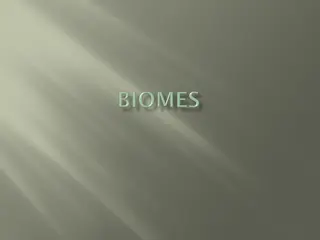Comparing Natural Selection in Diverse Biomes: Spanish Cattle Adaptations
Explore the natural selection of Spanish cattle in desert, swamp, and grassland ecosystems. Compare characteristics of Cracker and Chinampo cattle, highlighting their adaptations for survival in different biomes. Discover how these species thrive in challenging environments through unique physical and behavioral traits.
Download Presentation

Please find below an Image/Link to download the presentation.
The content on the website is provided AS IS for your information and personal use only. It may not be sold, licensed, or shared on other websites without obtaining consent from the author.If you encounter any issues during the download, it is possible that the publisher has removed the file from their server.
You are allowed to download the files provided on this website for personal or commercial use, subject to the condition that they are used lawfully. All files are the property of their respective owners.
The content on the website is provided AS IS for your information and personal use only. It may not be sold, licensed, or shared on other websites without obtaining consent from the author.
E N D
Presentation Transcript
BosTaurus Comparing Natural Selection in Ecosystems of Diverse Biomes
Vocabulary Biome an area that is defined by its geography and climate. Ecosystem - a system formed by the interaction of a community of organisms with abiotic and biotic factors Abiotic Factors - non-living factors within an ecosystem such as temperature and water Biotic Factors living and previously living factors within an ecosystem such as plants Adaptation -the ability of a species to survive in a particular ecological biome due to alterations of form or behavior brought about through natural selection
Comparing naturally selected adaptation of Spanish Cattle in Desert, Swamp and Grassland Ecosystems Chinampo Cattle Cracker Cattle http://www.desertmuseum.org/desert/habitats/tscrub/coast02_300.jpg Longhorn Cattle
Cracker Cattle Atlantic and Gulf Coast areas of Florida, Georgia, Alabama and Mississippi Biome dense swamp, thick scrub heavily wooded lowland areas with fast growing lush vegetation that has a high salt, low protein and mineral content. Cougars and packs of coyote are natural predators in this area
Cracker Cattle Charateristics Cows weight 450-800 lbs Bulls weight 800-1200 lbs Horns: Small bases that turn up close to their base and produce a wide variety of shapes frequently turning up close to the head. High salt, low mineral and protein content of available food Usually calves every two years.
Chinampo Cattle Baja, California, Mexico. Biome Chaparral (a thorn scrub desert area with thick cactus and brush type vegetation) Packs of coyote and cougars are predators in this are
Characteristics of Chinampo Cattle Cow weigh 600 to 800 pounds Bull weight 700-1000 lbs. Horns small base and are not as long as the Texas longhorn. Chinampo cattle forage at night browsing mainly on shrubs mesquite and cactus. Most of the vegetation has little nutritional value. However, protein levels are highest in brush and shrub especially during periods of high growth. Chinampo Cattle have a lower metabolic rate and can live several days without water.
Longhorn Cattle Texas and Northern Mexico Biome brush and grass lands with high protein grass and vegetation that has high nutritional value. Natural predators would include the cougar, wolf, and Native Americans.
Characteristics of Longhorn Cattle Cow weight 800-900 Bull weight 1200-1400 Horns long wide horns with thick horn bases and a variety of shapes 90% of longhorn cows calve yearly. Longhorns browse on a wide variety of brush and grasses. Prairie grass were abundant throughout most of the year. They have high protein other food sources include oak and other brush and cactus.
TEKS Middle School Science, Grade 7 112.19.b (11) Organisms and environments. The student knows that populations and species demonstrate variation and inherit many of their unique traits through gradual processes over many generations. The student is expected to: (B) explain variation within a population or species by comparing external features, behaviors, or physiology of organisms that enhance their survival such as migration, hibernation, or storage of food in a bulb; and (C) identify some changes in genetic traits that have occurred over several generations through natural selection and selective breeding such as the Galapagos Medium Ground Finch (Geospiza fortis) or domestic animals. (14) Organisms and environments. The student knows that reproduction is a characteristic of living organisms and that the instructions for traits are governed in the genetic material. The student is expected to: (A) define heredity as the passage of genetic instructions from one generation to the next generation; High School Biology 112.34. c (7)Science concepts. The student knows evolutionary theory is a scientific explanation for the unity and diversity of life. The student is expected to: (C) analyze and evaluate how natural selection produces change in populations, not individuals; (D) analyze and evaluate how the elements of natural selection, including inherited variation, the potential of a population to produce more offspring than can survive, and a finite supply of environmental resources, result in differential reproductive success; (E) analyze and evaluate the relationship of natural selection to adaptation and to the development of diversity in and among species; (8) Science concepts. The student knows that taxonomy is a branching classification based on the shared characteristics of organisms and can change as new discoveries are made. The student is expected to: (12) Science concepts. The student knows that interdependence and interactions occur within an environmental system. The student is expected to: (B) compare variations and adaptations of organisms in different ecosystems; (D) recognize that long-term survival of species is dependent on changing resource bases that are limited; (F) describe how environmental change can impact ecosystem stability.
Bibliography Brian R. West, "Selective Breeding". March 10 2009. http://www.bookrags.com/research/selective-breeding-ansc-04/B Scott P. Greiner, Beef Cattle Breeds and Biological Types . November 2002 Extension Animal Scientist; Virginia Tech http://www.ext.vt.edu/pubs/beef/400-803/400-803.html#L2 Larry V. Cundiff, Ferenc Szabo , Keith E. Gregory, R. M. Koch, M. E. Dikeman , and J. D. Crouse Breed Comparisons in the Germplasm Evaluation Program at MARC U.S. Department of Agriculture http://www.ansi.okstate.edu/breeds/research/marccomp.htm Michael Casey, Genetic Advantages of Texas Longhorn Cattle http://www.fairlealonghorns.com/Articles/genetic.html John E Rouse, World Cattle III, Cattle of North America , University of Oklahoma Press: Norman, 1973 International Texas Longhorn Association http://www.itla.net/Longhorn_Information/index.cfm?con=faq Cora Oltersdorf, A Dying Breed , Alcalde, November/December 2002 Cattleman s Texas Longhorn Registry http://www.ctlr.org/Resources/Alcalde/index.html D.E. Ray, S. B. Itulya, C.B. Roubicek and C. R. Benson, Pregnancy Rate, Calf Mortality and Calving Date in Unsupplemented Hereford Range cows , Livestock Production Science Volume 23, Issue 3-4, Pages 305-315 http://www.sciencedirect.com Julie Pack, Breed Comparisons in the Germplasm Evaluation Program at MARC U.S. Department of Agriculture http://www.ansi.okstate.edu/breeds/research/marccomp.htm This Power Point was developed by Kristene Newcomb for Cattlemen s Texas Longhorn Conservancy and the State Herds of Texas. You are welcome to use it in your class room. Kristene@folsomfallies.com























